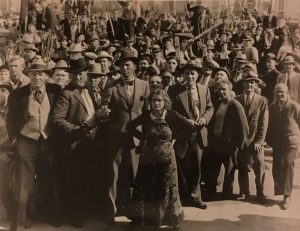Research in progress, May 10, 2023
Fritz Lang Career Summary:
Occupational Inheritance: No
Social Class: Upper-Middle
Nationality: Austrian, lived Berlin; exile in Hollywood
Education: he initially studied to become artist and architect
Training:
First Film:
Turning Point: Metropolis, 1927; M, 1931
First Oscar Nomination: NA
Other Nominations: NA
Genre (specialties): sci-fi; film noir
Collaborators:
Last Film:
Contract:
Career Output:
Career Span: 1919-1960
Marriage:
Politics:
Retirement: 1960; age 70
Death: 1976, stroke; 85
Fritz Lang is one of the most influential directors in world cinema.
Fury (1936): Lang’s First American Film
Unlike some of his contemporaries, such as Robert Siodmak or Fred Zinnemann, Lang had never been nominated for the Best Director Oscar, and none of his Hollywood film was particularly successful at the box-office.
At his prime, he was an innovator in a number of genres. He invented the sci-fi genre with Metropolis in 1927.
He launched the spy feature with “Spies” and “Dr. Mabuse: The Gambler.”
No director had worked within the genre of film noir more consistently or more brilliantly than Viennese born German filmmaker Fritz Lang.
Bringing to the screen an obsessive and fatalistic world populated by a rogues’ gallery of strange and twisted characters, Lang staked out a hostile corner of the cinematic universe; despair, fatalism, isolation, helplessness–are major themes in his work.
Filmography
1919–1933: 16
Halbblut (1919)
Der Herr der Liebe (1919)
The Spiders, Part 1 (1919)
Harakiri (1919)
The Spiders, Part 2 (1920)
The Wandering Image (1920)
Four Around a Woman (1921)
Destiny (1921)
Dr. Mabuse the Gambler (1922)
Die Nibelungen: Siegfried (1924)
Die Nibelungen: Kriemhilds Rache (1924)
Metropolis (1927)
Spione (1928)
Woman in the Moon (1929)
M (1931)
The Testament of Dr. Mabuse (1933)
1934–1956: 24 features (23 in Hollywood)
Liliom (1934), made in Paris
Fury (1936)
You Only Live Once (1937)
You and Me (1938)
The Return of Frank James (1940)
Western Union (1941)
Man Hunt (1941)
Moontide (1942)
Hangmen Also Die! (1943)
Ministry of Fear (1944)
The Woman in the Window (1944)
Scarlet Street (1945)
Cloak and Dagger (1946)
Secret Beyond the Door (1948)
House by the River (1950)
American Guerrilla in the Philippines (1950)
Rancho Notorious (1952)
Clash by Night (1952)
The Blue Gardenia (1953)
The Big Heat (1953)
Human Desire (1954)
Moonfleet (1955)
While the City Sleeps (1956)
Beyond a Reasonable Doubt (1956)
Later
The Tiger of Eschnapur (1959)
The Indian Tomb (1959)
The Thousand Eyes of Dr. Mabuse (1960)




